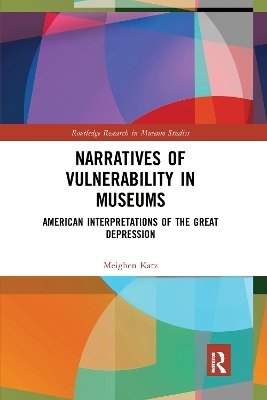
Narratives of Vulnerability in Museums
American Interpretations of the Great Depression
Seiten
2021
Routledge (Verlag)
978-0-367-72752-9 (ISBN)
Routledge (Verlag)
978-0-367-72752-9 (ISBN)
A study of the challenges museums face when they present narratives of instability, uncertainty and fear in their exhibitions. Analysing a range of case studies, the book explores both the successes and obstacles involved in translating historical narratives of vulnerability to the exhibition floor.
Narratives of Vulnerability in Museums is a study of the challenges museums face when they present narratives of instability, uncertainty, and fear in their exhibitions. As a period of sustained societal and personal vulnerability, the Great Depression remains a watershed era in American history. It is an era when iconic visual culture of deprivation mixes in the popular imagination with groundbreaking government policy and has immense potential for museums, but this is accompanied by significant challenges. Analysing a range of case studies, the book explores both the successes and obstacles involved in translating historical narratives of vulnerability to the exhibition floor.
Incorporating an innovative, trans-genre museological model, the book draws connections between exhibitions of history, art, and technology, as well as heritage sites, focused on a single era. Employing interpretations of housing, preserved and reconstructed, to discuss ideas of belonging and community, the book also examines the power of the iconic national story and the struggle for local relevance through discussions on strikes and industrial action. Finally, it examines the use of fine art in history exhibitions to access the emotional aspects of historical experience. The result is a volume that considers both how societies talk about less celebratory aspects of history, but also the expectations placed on museums as interpreters of the public narrative and agents of change.
Narratives of Vulnerability in Museums makes a significant contribution to discourses of museum and heritage studies, of interwar history, of the social role of cultural institutions, and to vulnerability and resilience studies. As such, it should be essential reading for scholars and students working in these disciplines, as well as architecture, cultural studies, and human geography.
Narratives of Vulnerability in Museums is a study of the challenges museums face when they present narratives of instability, uncertainty, and fear in their exhibitions. As a period of sustained societal and personal vulnerability, the Great Depression remains a watershed era in American history. It is an era when iconic visual culture of deprivation mixes in the popular imagination with groundbreaking government policy and has immense potential for museums, but this is accompanied by significant challenges. Analysing a range of case studies, the book explores both the successes and obstacles involved in translating historical narratives of vulnerability to the exhibition floor.
Incorporating an innovative, trans-genre museological model, the book draws connections between exhibitions of history, art, and technology, as well as heritage sites, focused on a single era. Employing interpretations of housing, preserved and reconstructed, to discuss ideas of belonging and community, the book also examines the power of the iconic national story and the struggle for local relevance through discussions on strikes and industrial action. Finally, it examines the use of fine art in history exhibitions to access the emotional aspects of historical experience. The result is a volume that considers both how societies talk about less celebratory aspects of history, but also the expectations placed on museums as interpreters of the public narrative and agents of change.
Narratives of Vulnerability in Museums makes a significant contribution to discourses of museum and heritage studies, of interwar history, of the social role of cultural institutions, and to vulnerability and resilience studies. As such, it should be essential reading for scholars and students working in these disciplines, as well as architecture, cultural studies, and human geography.
Meighen Katz has lectured at the University of Melbourne, the Australian Catholic University, and Deakin University; she contributed to exhibitions at Museum Victoria; and she was the 2016 Grimwade Curator at the Ian Potter Museum of Art. She holds a PhD from Monash University and is a founding partner of Present Past Consulting Historians.
1. Introduction: The Great Depression, Museums, and Narratives of Vulnerability
2. Shaking Off the Dust Bowl: Strikes and the Challenge of Iconic History
3. Belonging: Interpretations of Home, Homelessness, and Neighborhoods
4. The Arts and the Imagined Audience: Theatre, Radio, and the Emotion of Vulnerability
5. The Big Ball of String: Concluding Thoughts
| Erscheinungsdatum | 06.04.2021 |
|---|---|
| Reihe/Serie | Routledge Research in Museum Studies |
| Verlagsort | London |
| Sprache | englisch |
| Maße | 156 x 234 mm |
| Gewicht | 317 g |
| Themenwelt | Kunst / Musik / Theater |
| Geschichte ► Allgemeine Geschichte ► Neuzeit (bis 1918) | |
| Geisteswissenschaften ► Geschichte ► Hilfswissenschaften | |
| Geisteswissenschaften ► Geschichte ► Regional- / Ländergeschichte | |
| ISBN-10 | 0-367-72752-8 / 0367727528 |
| ISBN-13 | 978-0-367-72752-9 / 9780367727529 |
| Zustand | Neuware |
| Haben Sie eine Frage zum Produkt? |
Mehr entdecken
aus dem Bereich
aus dem Bereich
Europa 1848/49 und der Kampf für eine neue Welt
Buch | Hardcover (2023)
DVA (Verlag)
CHF 67,20
Giordano Bruno - ein ketzerisches Leben
Buch | Hardcover (2024)
C.H.Beck (Verlag)
CHF 41,85


